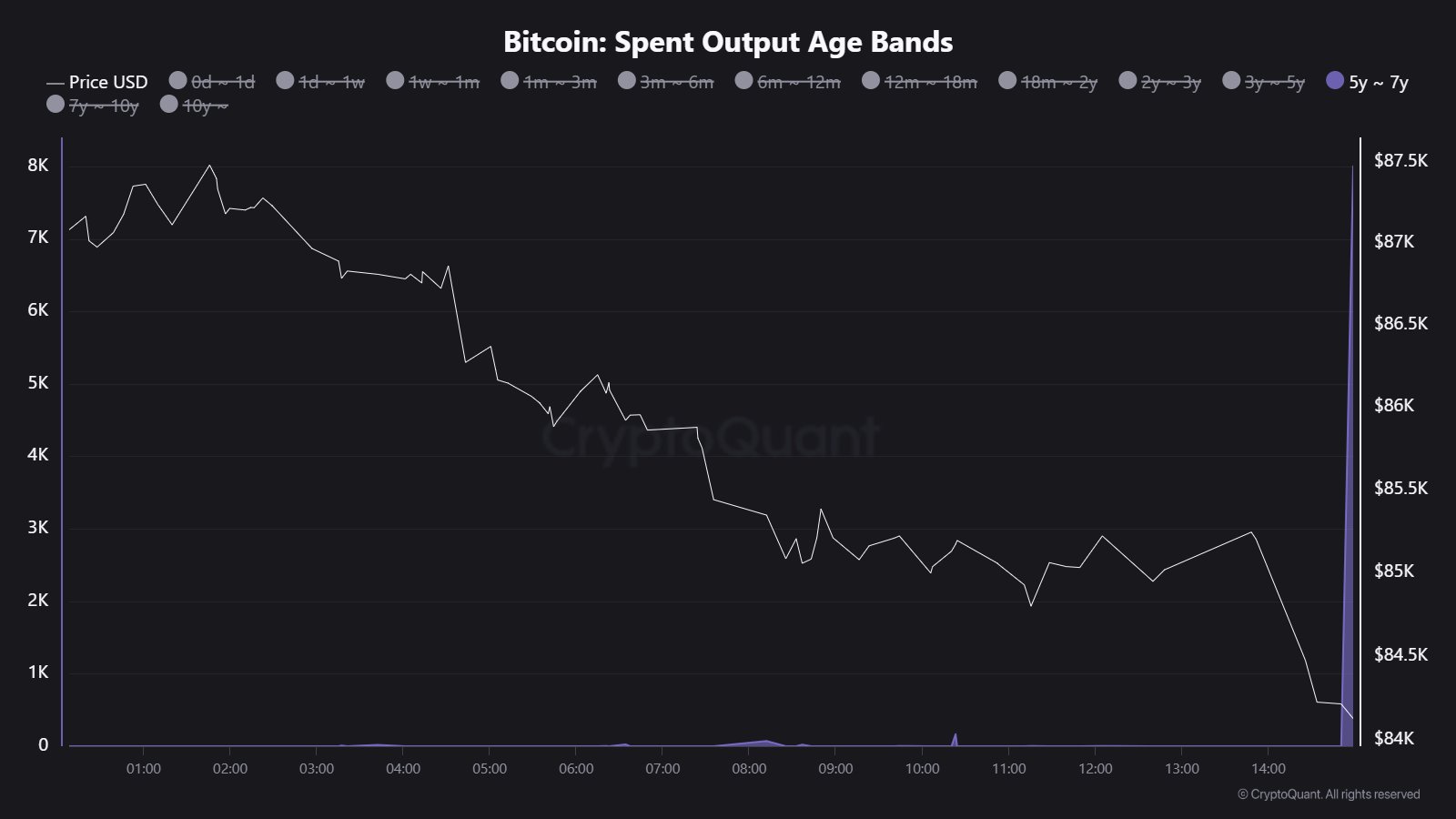Bitcoin
Riot Platforms Q1 Earnings Surge as the Stock Price Drops

Riot Platforms, a US-based Bitcoin mining company, recently unveiled a remarkable financial performance for the first quarter 2024. The company announced total revenues of $79.3 million, a noticeable uptick from $73.2 million during the same period last year.
Riot also reported a net income of $211.8 million, earnings per share of $0.82, and $245.7 million in adjusted EBITDA—new highs for the company’s quarterly financial performance. A significant 131% rise in Bitcoin prices, compared to the same three-month period in 2023, largely accounts for this increase.
Bitcoin Price Surge Drives Record-Breaking Quarter for Riot Platforms
Riot’s report revealed that it secured $5.1 million in power curtailment credits. The number is a boost from $3.1 million last year, demonstrating adept management of operational efficiencies.
The Bitcoin Mining segment alone brought in $74.6 million. The number is significantly higher than last year’s $48.0 million, driven by the favorable Bitcoin pricing environment. Conversely, the Engineering segment declined, generating $4.7 million compared to $16.1 million in the previous year.
Riot maintains a robust financial position with $692.5 million in working capital. It also reported $688.5 million in cash and 8,490 unencumbered Bitcoin valued at approximately $605.6 million as of March 31, 2024.
Additionally, the energization of the Corsicana Facility substation was a significant development in the quarter. The facility is slated to be the world’s largest Bitcoin mining facility upon full development.
Besides the Corsicana Facility, Riot also expects its previous purchase from MicroBT in June 2023 to enhance self-mining hash rate capacity. The deployment of these miners has begun and is projected to conclude by the second half of 2025.
“We remain on track to increase our self-mining hash rate capacity to 31 EH/s by the end of the year, which will nearly triple our existing hash rate capacity. With up to 1 GW of total capacity when fully developed, the Corsicana Facility … gives us a strong foundation upon which we will continue scaling our Bitcoin mining business in the future,” Jason Les, Riot Platform’s CEO, stated.
Read more: 5 Best Platforms To Buy Bitcoin Mining Stocks
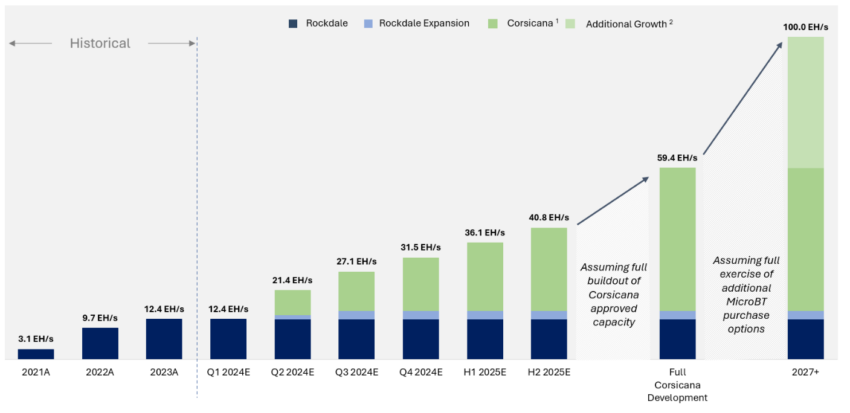
However, Riot experienced a reduction in its Bitcoin production. Riot mined 1,364 Bitcoins in the first quarter, marking a 36% decrease from the 2,115 Bitcoins produced in Q1 2023.
The downturn in production can be traced back to the soaring Bitcoin network difficulty, which has more than doubled since January 2023. This presents a formidable challenge for miners.
Furthermore, the average cost to mine a single Bitcoin soared to $23,034, dramatically increasing from $9,438 in the previous year. This surge reflects the 89% increase in the global network hash rate over the same period. At the same time, it also presents the escalating operational challenges in the mining industry.
Indeed, the mining sector remains fraught with challenges. The escalating electricity costs and the impending reduction in Bitcoin supply due to the halving event could squeeze operational margins. Regarding the current Bitcoin production cost, Charles Edwards, founder of Capriole Fund, shared his perspectives.
“This means 1 of 3 things happens now: 1. Price skyrockets, 2. ~15% of miners shut down, 3. Transaction fees remain a lot higher on average,” Edwards wrote while admitting he is “expecting a bit of all three.”
In response to the latest outlook, analysts see some miners might diversify their business into emerging technologies such as artificial intelligence (AI). Analysts consider this shift a strategic move to mitigate the risks of the volatile crypto market while leveraging their computational power beyond crypto mining.
However, a January 2024 study by CoinShares suggests that miners with substantial Bitcoin reserves and robust capitalization are better positioned in bullish markets. In contrast, those with limited cash reserves and high operational costs per Bitcoin face heightened risks.
Riot’s strong performance in Q1 has yet to affect the company’s stock price positively. The stock price has decreased by 11.77% over the past five days.
Read more: Best Crypto Mining Stocks to Buy or Watch Now
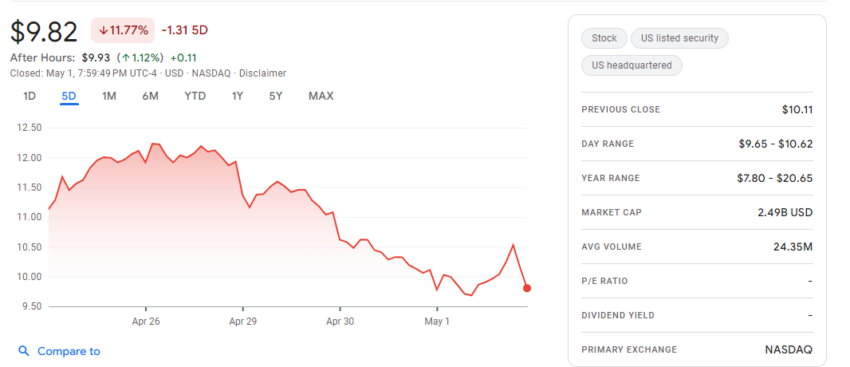
The broader timeframe presents a similar picture, with RIOT down 36.28% from its year-to-date peak price of $17.62. At the time of writing, RIOT’s price is $9.82 during after-hours trading.
Disclaimer
In adherence to the Trust Project guidelines, BeInCrypto is committed to unbiased, transparent reporting. This news article aims to provide accurate, timely information. However, readers are advised to verify facts independently and consult with a professional before making any decisions based on this content. Please note that our Terms and Conditions, Privacy Policy, and Disclaimers have been updated.
Bitcoin
Gold Keeps Outperforming Bitcoin Amid Trump’s Trade War Chaos
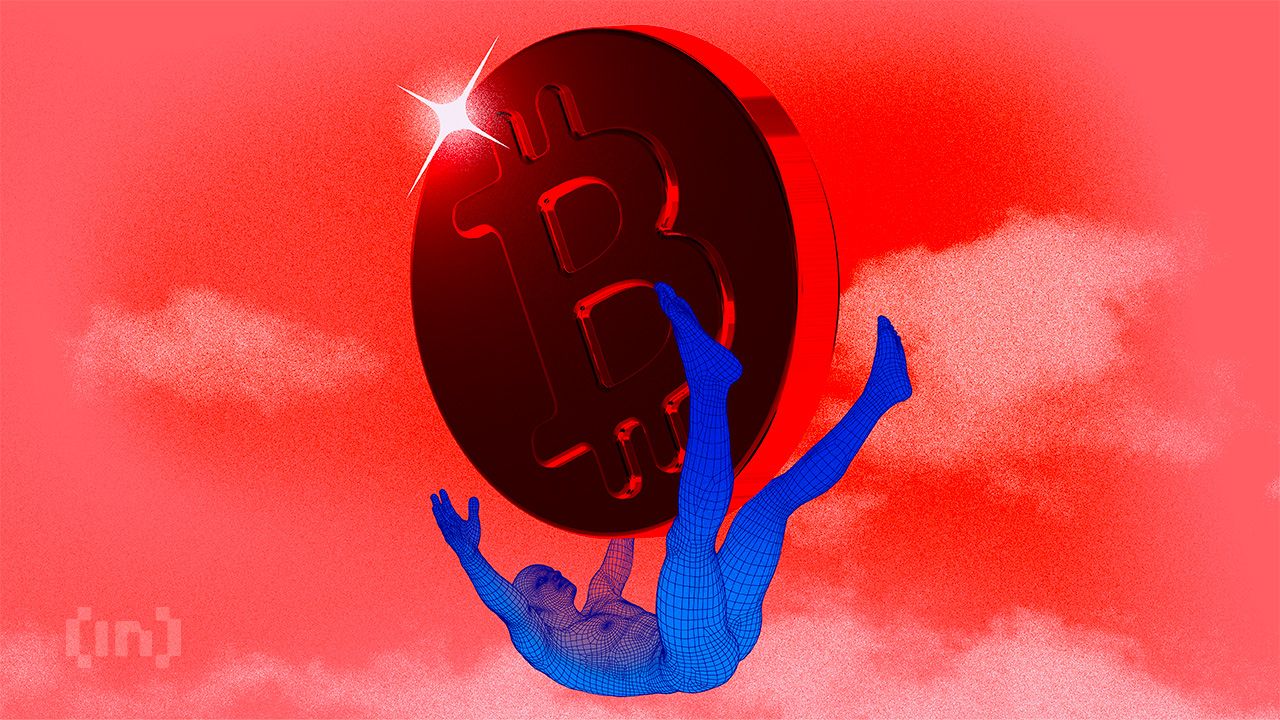
Bitcoin (BTC) has long been touted as “digital gold.” However, as the global economy reels from escalating trade war tensions under Trump’s second term, institutional investors are fleeing to the real thing.
A recent Bank of America (BofA) survey found that 58% of fund managers view gold as the best-performing haven in a trade war—leaving Bitcoin with only a 3% preference.
Bitcoin’s Haven Status Faces a Reality Check
Gold is proving its dominance as the crisis asset of choice while Bitcoin struggles to hold its ground. This comes amid rising geopolitical risks, the ballooning US deficit, and uncertainty driving capital flight.
“In a recent Bank of America survey, 58% of fund managers said gold performs best in a trade war. This compares to just 9% for 30-year Treasury Bonds and 3% for Bitcoin,” The Kobeissi Letter noted.
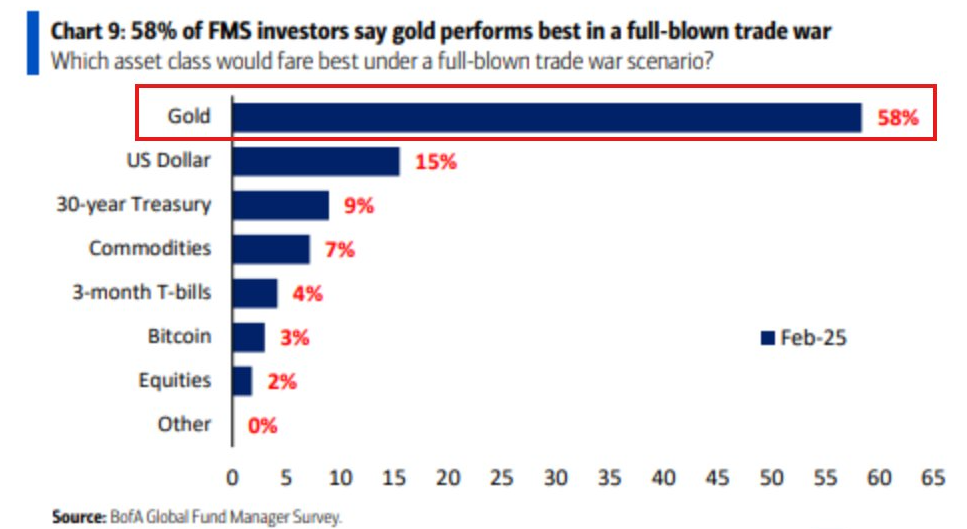
For years, Bitcoin advocates have championed it as a hedge against economic instability. Yet, in 2025’s volatile macro environment, Bitcoin struggles to earn institutional investors’ full trust.
The Bank of America survey reflects this status, with long-term US Treasury bonds and even the US dollar losing appeal as trade wars and fiscal dysfunction shake market confidence.
The US deficit crisis—now projected to exceed $1.8 trillion—has further eroded confidence in traditional safe havens like US Treasuries.
“This is what happens when the global reserve currency no longer behaves as the global reserve currency,” a trader quipped in a post.
However, instead of looking to Bitcoin as an alternative, institutions are overwhelmingly choosing gold, doubling physical gold purchases to record levels.
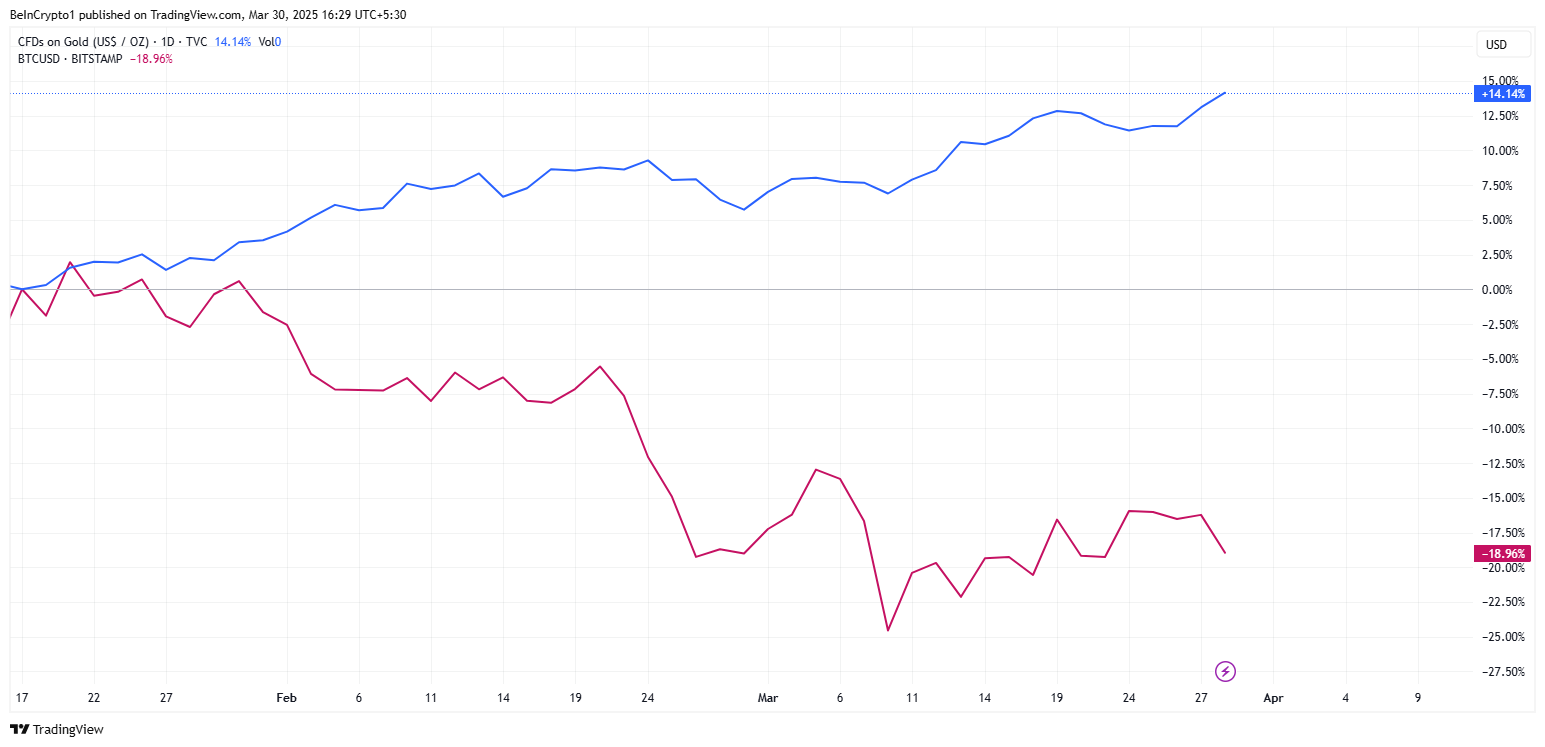
Barriers To Bitcoin Institutional Adoption
Despite its fixed supply and decentralization, Bitcoin’s short-term volatility remains a key barrier to institutional adoption as a true safe-haven asset.
While some traders still view Bitcoin as a long-term store of value, it lacks the immediate liquidity and risk-averse appeal that gold provides during crises.
Further, President Trump is expected to announce sweeping new tariffs on “Liberation Day.” Experts flag the event as a potential trigger for extreme market volatility.
“April 2nd is similar to election night. It is the biggest event of the year by an order of magnitude. 10x more important than any FOMC, which is a lot. And anything can happen, “Alex Krüger predicted.
Trade tensions have historically driven capital into safe-haven assets. With this announcement looming, investors preemptively position themselves again, favoring gold over Bitcoin.
“Gold’s no longer just a hedge against inflation; it’s being treated as the hedge against everything: geopolitical risk, de-globalization, fiscal dysfunction, and now, weaponized trade. When 58% of fund managers say gold is the top performer in a trade war, that’s not just sentiment that’s allocation flow. When even long bonds and the dollar take a back seat, it’s a signal: the old playbook is being rewritten. In a world of rising tariffs, FX tension, and twin deficits, gold might be the only politically neutral store of value left,” trader Billy AU observed.
Despite Bitcoin’s struggle to capture institutional safe-haven flows in 2025, its long-term narrative remains intact.
Specifically, the global reserve currency system is changing, US debt concerns are mounting, and monetary policies continue to shift. Despite all these, Bitcoin’s value proposition as a censorship-resistant, borderless asset is still relevant.
However, in the short term, its volatility and lack of widespread institutional adoption as a crisis hedge mean gold is taking the lead.
For Bitcoin believers, the key question is not whether Bitcoin will one day challenge gold but how long institutions will adopt it as a flight-to-safety asset.
Until then, gold remains the undisputed king in times of economic turmoil. Meanwhile, Bitcoin (BTC exchange-traded funds notwithstanding) fights to prove its place in the next financial paradigm shift.
“The ETF demand was real, but some of it was purely for arbitrage…There was a genuine demand for owning BTC, just not as much as we were led to believe,” analyst Kyle Chassé said recently.
Disclaimer
In adherence to the Trust Project guidelines, BeInCrypto is committed to unbiased, transparent reporting. This news article aims to provide accurate, timely information. However, readers are advised to verify facts independently and consult with a professional before making any decisions based on this content. Please note that our Terms and Conditions, Privacy Policy, and Disclaimers have been updated.
Bitcoin
Why Bitcoin Seasoned Investors Are Accumulating — Analyst Evaluates BTC’s Current Phase


The cryptocurrency market has not had a clear direction in 2025, reflecting the uncertain condition of the digital asset industry. Bitcoin, the world’s largest cryptocurrency by market capitalization, is currently 24% away from its record-high price of $108,786 reached in January 2025.
With the premier cryptocurrency steadily drifting away from its all-time high, there have been questions about what phase of the cycle the market is currently in. Interestingly, recent on-chain data offers some insight into the current state of the Bitcoin market and the reaction of the participants.
Are Seasoned BTC Investors Anticipating A Price Surge?
In a Quicktake post on the CryptoQuant platform, analyst Axel Adler Jr. shared an analysis of the current Bitcoin cycle, offering insight into the behavior of an important group of investors. According to the online pundit, seasoned BTC players are back to accumulating the flagship cryptocurrency.
Adler Jr. revealed that the experienced BTC investors have been involved in four phases of accumulation (January 2023, October 2023, October 2024, March 2025) in the current cycle. On the flip side, the selling activity of these market participants has reached four distinct peaks, including January 2024, April 2024, July 2024, and January 2025.
The relevant on-chain indicator here is the Value Days Destroyed (VDD) metric, which tracks the spending behaviour of long-term investors. The chart below shows that the VDD metric has been steadily declining since the start of 2025.

Source: CryptoQuant
Using the chart as a basis, Adler Jr. mentioned that three major features define the current phase of the Bitcoin cycle. Firstly, the seasoned investors, who were actively distributing their BTC at local peaks, have now shifted their strategy toward holding and accumulating their coins.
Additionally, the Value Days Destroyed metric suggests an absence of significant selling pressure, which means that the experienced traders are skeptical about profit at the current Bitcoin price. Moreover, periods of low VDD values have historically preceded significant upward price movements, as investors accumulate in anticipation of a price surge.
Ultimately, this positive shift in the behavior of seasoned Bitcoin holders suggests that there might be room for further price growth for Bitcoin in the medium term.
Bitcoin Price At A Glance
As of this writing, the price of BTC sits at around $83,200, with an over 2% decline in the past 24 hours. According to data from CoinGecko, the flagship cryptocurrency is also down by about 2% on the weekly timeframe.
BTC price reclaims $83,000 level on the daily timeframe | Source: BTCUSDT chart on TradingView
Featured image created by DALL-E, chart from TradingView

Editorial Process for bitcoinist is centered on delivering thoroughly researched, accurate, and unbiased content. We uphold strict sourcing standards, and each page undergoes diligent review by our team of top technology experts and seasoned editors. This process ensures the integrity, relevance, and value of our content for our readers.
Bitcoin
8,000 Dormant Bitcoin Suddenly Move: What’s Next For The Market?

Popular CryptoQuant analyst Maartunn reports that 8,000 Bitcoin (BTC) which have been dormant for five to seven years have been moved suddenly, adding to current bearish concerns in the crypto. This development comes after a rather adventurous week as BTC prices struggled to break above $89,000, following an initial steady bullish climb, before succumbing to heavy selling pressures driven by US President Donald Trump’s hawkish tariff policy.
$674 Million In Old BTC Transfers In Single Block – Cause For Alarm?
The Spent Output Age Bands is a crucial metric to measure how long Bitcoin tokens remain inactive before moving. According to Maartuun in an X post, this metric has recently revealed that 8,000 BTC worth $674 million that was last transferred between 2018 and 2020 have been moved recently in a single block drawing significant market attention.
This transfer follows a string of recent activations of dormant Bitcoin stashes. On March 24, a 14-year inactive Bitcoin wallet suddenly moved 100 Bitcoin valued at $8.5 million. Meanwhile, in early March, six ancient Bitcoin wallets also transferred nearly 250 BTC worth $22 million.
Notably, the most recent transaction reported by Maartuun is of far larger size with potentially strong implications for an uncertain Bitcoin market. Generally, a movement of such a large amount of BTC from long-term dormancy is usually interpreted as a signal for incoming selling pressure leading to major price corrections.
However, there are other potential non-bearish motives behind such transactions such as internal wallet shuffling by institutional investors or large holders as well as a cold storage reorganization. Currently, the owners of the new wallets receiving the 8000 is unknown thus reducing the potential of a bearish reaction from BTC holders.
Bitcoin Price Overview
In the last day, Bitcoin prices declined by 4.00% after the US Government announced intentions to impose a 25% tariff on auto imports and goods from China, Mexico, and Canada starting from April 3. This marks the latest negative reaction of the crypto market to President Trump’s international trade policies following similar incidents in early February and mid-March.
These measures by the Donald Trump administration are flaming fears of a potential economic slowdown which could further push high-risk assets such as BTC out of investors’ portfolios leading to a further downside.
At press time, Bitcoin currently trades at $83,693 reflecting a decline of 0.72% and 2.53% in the last seven and 30 days respectively. Meanwhile, the asset’s daily trading volume is up by 19.38% and is valued at $31.58 billion. The BTC market cap now stands at $1.66 trillion and still represents a dominant 61.1% of the total crypto market.
BTC trading at $83,727 on the daily chart | Source: BTCUSDT chart on Tradingview.com
-

 Ethereum19 hours ago
Ethereum19 hours agoWhales Accumulate 470,000 Ethereum In One Week – Bullish Momentum Ahead?
-

 Market22 hours ago
Market22 hours agoWhale Leverages $27.5 Million PEPE Long on Hyperliquid
-
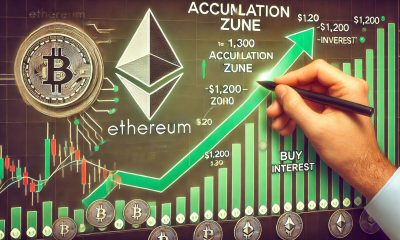
 Ethereum20 hours ago
Ethereum20 hours agoEthereum Analyst Eyes $1,200-$1,300 Level As Potential Acquisition Zone – Details
-

 Bitcoin20 hours ago
Bitcoin20 hours agoGold Keeps Outperforming Bitcoin Amid Trump’s Trade War Chaos
-

 Ethereum21 hours ago
Ethereum21 hours agoEthereum May Have Hit Cycle Bottom, But Pricing Bands Signal Strong Resistance At $2,300
-
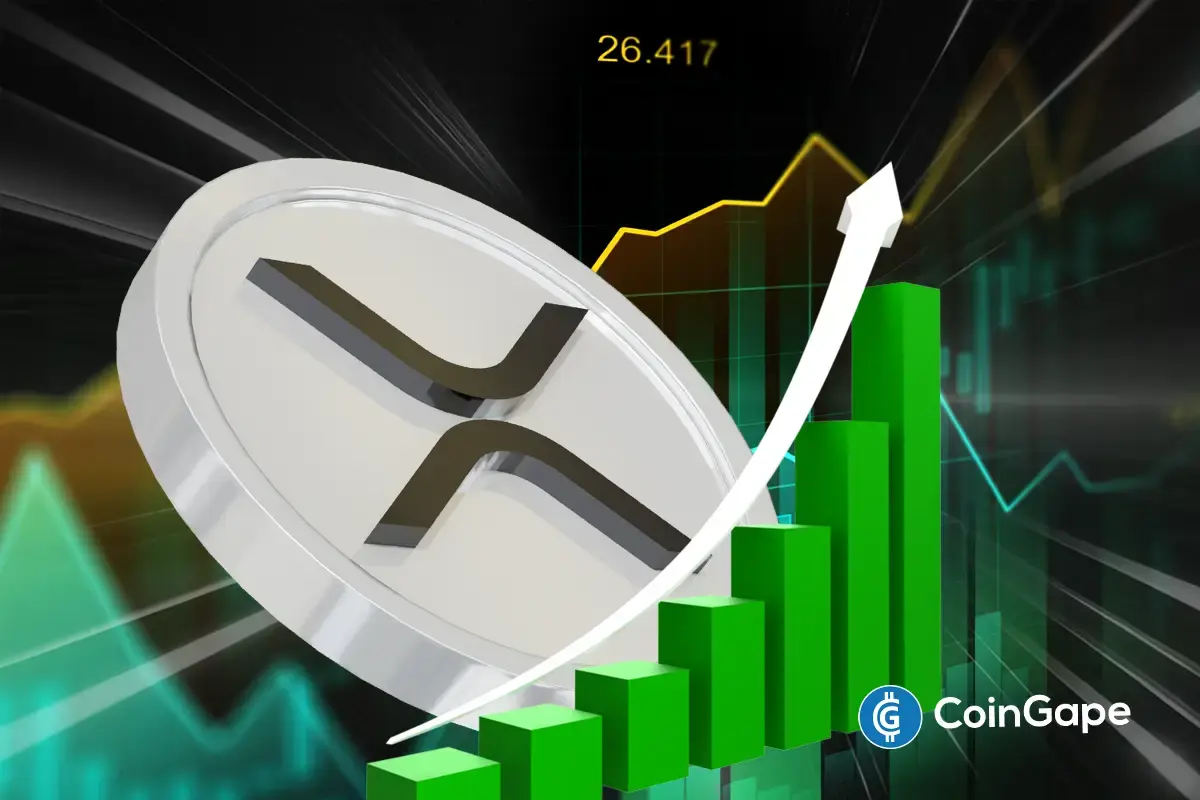
 Altcoin19 hours ago
Altcoin19 hours agoAnalyst Reveals Why The XRP Price Can Hit ATH In The Next 90 To 120 Days
-
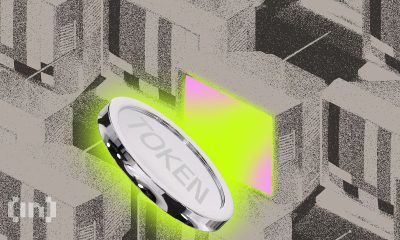
 Market18 hours ago
Market18 hours ago3 Token Unlocks for April: Parcl, deBridge, Scroll
-

 Ethereum23 hours ago
Ethereum23 hours agoEthereum Playing Catch-Up? Bloomberg Examines ETH’s Struggles In New Report












